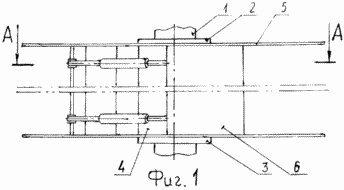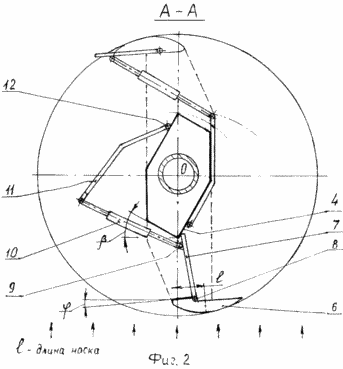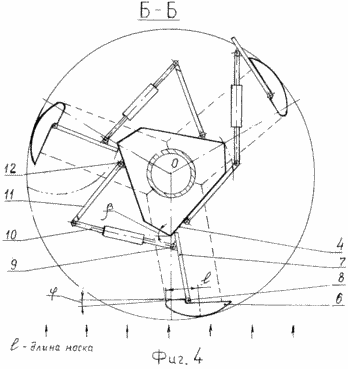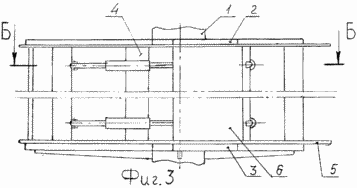| section Home
Production, Amateur Radio amateur Model aircraft, rocket- Useful, entertaining |
Stealth master
Electronics Physics Technologies invention |
space Mystery
Earth Mysteries Secrets of the Ocean Stealth section Map |
|
| Use of material is permitted for reference (for websites - hyperlinks) | |||
Navigation: => |
Home / Products Patents / In the section of the catalog / back / |
|
INVENTION
Russian Federation Patent RU2246635
![]()
Wind turbine for wind turbines with vertical rotation axis
Name of the inventor: Butakov Alexander
The name of the patentee: Butakov Alexander
Address for correspondence: 660075, Krasnoyarsk, ul. Railway, 21, kv.43, AN Butakov
Starting date of the patent: 2003.05.16
The invention relates to wind energy and can be used to generate wind power. The technical result is to simplify the design of a wind turbine and an increase in utilization of wind energy. Wind turbine with vertical axis of rotation is a rotor comprising a vertical shaft having tiers of arms and blades are rigidly mounted along the axis of rotation. Additionally the engine comprises a casing in the form of a prism, disposed between the bracket coaxially to the shaft, and horizontal screens, the blades are formed as aerodynamic wing with unilateral ailerons facing towards the housing and located at a distance less than the length of leading edge flap, each of said ailerons is fixed hinge wing to the body of the sock so that the free end can be simply supported on the face of the casing.
DESCRIPTION OF THE INVENTION
The invention relates to wind energy and can be used to generate wind power.
Known wind turbine with vertical axis of rotation, which is a rotor comprising a vertical shaft having tiers of arms and blades are rigidly mounted along the axis of rotation (see., E.g., SU 1455036 A1, cl. F 03 D 3/00, 30.01.1989) , the essential features adopted for the closest analogue of the invention (prototype).
K disadvantages include the complexity of the prototype design, low reliability, and low coefficient of performance (COP).
The technical result consists in simplifying the construction of a wind turbine and an increase in energy efficiency of wind and provided by the fact that the wind turbine with vertical axis of rotation, which is a rotor comprising a vertical shaft having tiers of arms and blades are rigidly mounted along the axis of rotation, according to the invention, further comprising a casing in the form of a prism, disposed between the bracket coaxially to the shaft, and horizontal screens, the blades are formed as aerodynamic wing with unilateral ailerons facing towards the housing and located at a distance less than the length of leading edge flap, each of said ailerons fixed hinge the body of the wing of the sock so that the free end can be simply supported on the face of the casing.
The ailerons sharnirnoteleskopicheskimi spring-loaded rods are connected in pairs with established along the vertical walls of the enclosure rotating blades.
On the opposite side serving as a support aileron, each face of the housing has a chamfer constituting a tangent to the circumference of the rotation angle of at least 15 degrees.

|
 |
 |
1 shows a wind turbine with two blades unturning, general view; Figure 2 shows a wind turbine, a section along A-A; 3 shows a wind turbine with three blades unturning, general view; 4 is a wind turbine, a section along B-B. Wind turbine is a vertical shaft 1, arranged in two tiers and rigidly attached thereto brackets 2 and 3, between which is placed coaxially with the shaft casing 4 covered with the ends 5 screens. The ends of the arms 2, 3 are connected in pairs unturning vertical blades 6, representing aerodynamic wing 7 with the aileron that the inside blade 6 is attached to the hinge 8 of 1 toe. The wing can be compressed (Original) or expanded (operating) position. In the second case the aileron turn 7 is limited to its reliance on the brink of the housing 4. |
Besides this, each aileron 7 by means arranged in the aft portion of the loop 9 sharnirnoteleskopicheskimi spring loaded rods 10 is connected to the vertical rotary blades 11 which are attached by hinges 12 to the brackets 2, 3 and the casing 4.
The principle of operation of a wind turbine is that, regardless of the wind direction shaft 1 is rotationally driven around "0" axis and operates as follows.
Thus, in one of the worst locations to start moving parts of a wind turbine, when all the ailerons 7 and the blade 11 are in the rest position, the wind direction can be for one of the blades 6 counter, but for others - incidental. Headwind will press the blade 11 to the casing 4, 7 aileron to the blade 6. In this state they do not have a large wind resistance.
On the other side of the wind turbine with the same direction of the wind flow of air acting on the tail part of the aileron 7 and slants with an angle ![]() Of not less than 15 degrees, resting on the tail portion of the blade 11, will turn them around their own axes of rotation 8, 12 so that the aileron 7 is simply supported on the brink of the housing 4.
Of not less than 15 degrees, resting on the tail portion of the blade 11, will turn them around their own axes of rotation 8, 12 so that the aileron 7 is simply supported on the brink of the housing 4.
At the same time, damping possible shocks reach a limiting length rod 10 which hold the blade 11 in the extreme working position, which in turn will make it possible to hold the operating position 7 aileron.
Further effects of air pressure on the blade 11, fenced housing 4 and screen 5 on three sides, there will be an increase in torque, which can surpass the resistance torque on the shaft 1. It will be turned on the angle at which the ailerons 7, fenced around the perimeter of the housing 4, screen 5 and the blade 6 is in operational position, thereby greatly increase the torque and the angular velocity of shaft rotation.
As a result, the shaft 1 is rotated so that other subsequent blade 6 and 11 take the original, similar to the original position. The cycle is repeated over and over again, causing the shaft to rotate at an appropriate rate.
CLAIM
1. Wind turbine with vertical axis of rotation, which is a rotor comprising a vertical shaft having tiers of arms and blades are rigidly mounted along the axis of rotation, characterized in that the housing further comprises a prism positioned between the bracket coaxially to the shaft, and horizontal screens , the blades are formed as aerodynamic wing with unilateral ailerons facing towards the housing and located at a distance less than the length of leading edge flap, each of said ailerons fixed hinge to the body of the wing of the sock so that the free end can be simply supported on the face of the casing.
2. Wind turbine according to claim 1, characterized in that the spring-hinged ailerons, telescopic rods mutually connected with established along the vertical walls of the enclosure rotating blades.
3. Wind turbine according to claim 1 or 2, characterized in that on the opposite side serving as a support aileron, each face of the housing has a chamfer constituting a tangent to the circle of rotation angle of at least 15 degrees.
print version
Publication date 31.01.2007gg





Comments
Commenting, keep in mind that the content and the tone of your messages can hurt the feelings of real people, show respect and tolerance to his interlocutors, even if you do not share their opinion, your behavior in terms of freedom of speech and anonymity offered by the Internet, is changing not only virtual, but real world. All comments are hidden from the index, spam control.